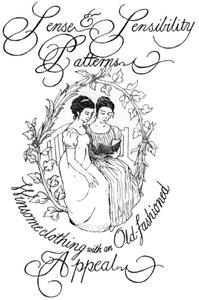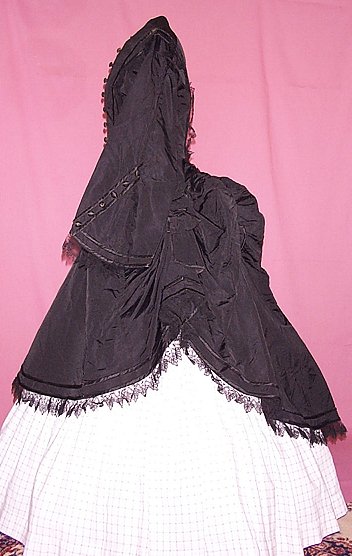1870s Bustled Polonaise
Here is a fantastic 1870s bustled polonaise sold on eBay by USVainen, a former seller whose knowledge of vintage fashion was astounding and whose descriptions were delightful. This seller graciously agreed to let me share her images and words on my site, and I think you'll enjoy them as much as I have!
High Fashion 1871 Silk Bustle Dress Polonaise: 1870-1872 were amazing years in fashion. The Franco-Prussian war abruptly ended the Paris fashion houses' stranglehold on world style when Napoleon III and his trend-setting wife, Eugenie, (along with many of the French nobility) left France for safety in Europe. Freed from the the tight constraints of Paris fashion trends, American women looked to history for inspiration when choosing their wardrobe. Styles were adapted from the Italian Renaissance, Dutch Classical, and (most importantly) from 18th century French Court opulence. At the same time that the Franco-Prussian war was occupying Europe, American fashion styles had been adapting to more realistic lines -- hoop skirts had been shrinking, and a new emphasis on walking encouraged fashion to place loops on the dress bottom hem so that the skirt could be raised and then fastened to either side seam to allow ease of walking (and incidentally show off a trim ankle and lavish petticoat). When the dress was fastened in this way, puffs (or bouffants as they were called in the Victorian era) were incidentally created on the sides and back of the dress. This style caught on, and quickly filled the fashion vacuum left by the departing Parisienne trendsetters. These "puffy" styles effectively signaled the end of the hoop skirt era of the 1850's and 1860's, and would evolve into the 30-year-long Victorian bustle period. Since the puffs in the back of the skirt were so reminiscent of the 18th century pannier look, women soon decided to incorporate more of that style into their dresses, and by 1871 a fashion fad was created that took the simple Civil War 1860's bodice, elongated it vertically, similar to 18th century panniered basque bodices, and created elaborate folds in the back of the bodice top just behind the waist. Copious use of laces and pleats were further added to 1870 fashion to closer match the 18th century look. This fashion statement lasted only 2-3 years before the Parisienne fashion houses (most notably, Charles Worth, who introduced a "basque" bustle dress that effectively removed the puffs and shrunk the skirt around 1875) reasserted their dominance in the fashion world. This dress is an amazingly preserved artifact of that wild and interesting 1870-1873 period. In this polonaise (bodice and attached overskirt), the influence of the 18th century pannier style is clearly evident in the wide hips and squared puffs in the back of the overskirt. Large pagoda sleeves (a natural extension of the 18th century huge cuffs) graceful smooth side lines all identify the age of this unique bodice.The polonaise's edges are lined with bands of shiny black silk piping and then further edged with matching black lace. Matching black silk covered buttons provide decorative accents on the bodice front and pagoda sleeves. The three bouffants in the rear are separated by self-fabric and black silk-trimmed bows. The inside of the bodice is boned and features bustle ties to hold the shape of the bodice; and the button holes are all carefully and professionally hand sewn.In addition to its peerless style, this polonaise is constructed of midnight black, fine-ribbed silk faille - among the most expensive of the silks in the Victorian period. Silk faille is thick, has a ribbed texture and notable shine. Only the wealthiest and most affluent of society's upper class could afford a dress of this quality and amount of material. The faille and silk piping is complemented by scallop-edged lace sporting a leaf motif. This lace trims all of the important lines of the 1871 style of this bodice. The only thing this polonaise needs to create an absolutely stunning style piece is a black underskirt. This is haute couture at its finest - obviously worn by a woman of prominence in one of America's major East Coast cities.









